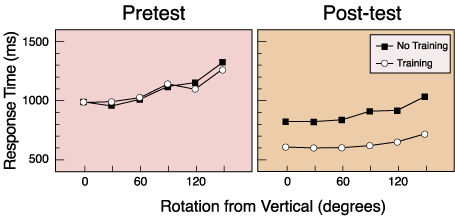Task: Sixteen adults judged if a stimulus presented in different orientations was a letter (F, G, P, R) or a mirror image of a letter. The stimuli were presented 0, 30, 60, 90, 120, or 150 degrees rotated from the vertical.
Interpretation: The no-training participants improved on their second try at the task. The training participants
improved much more. They improved on two separate skills: (1)
mental rotation, as inferred from the decrease in slope of the line, and
(2) encoding of
spatial information, as inferred from the intercept of the line.
Training: Of the 16 adults, 8 received training on the task; the others did not. The training consisted hundreds of trials with feedback on correctness. During training, participants received a monetary reward if their average response time improved without a drop in accuracy.

